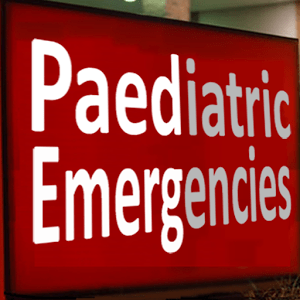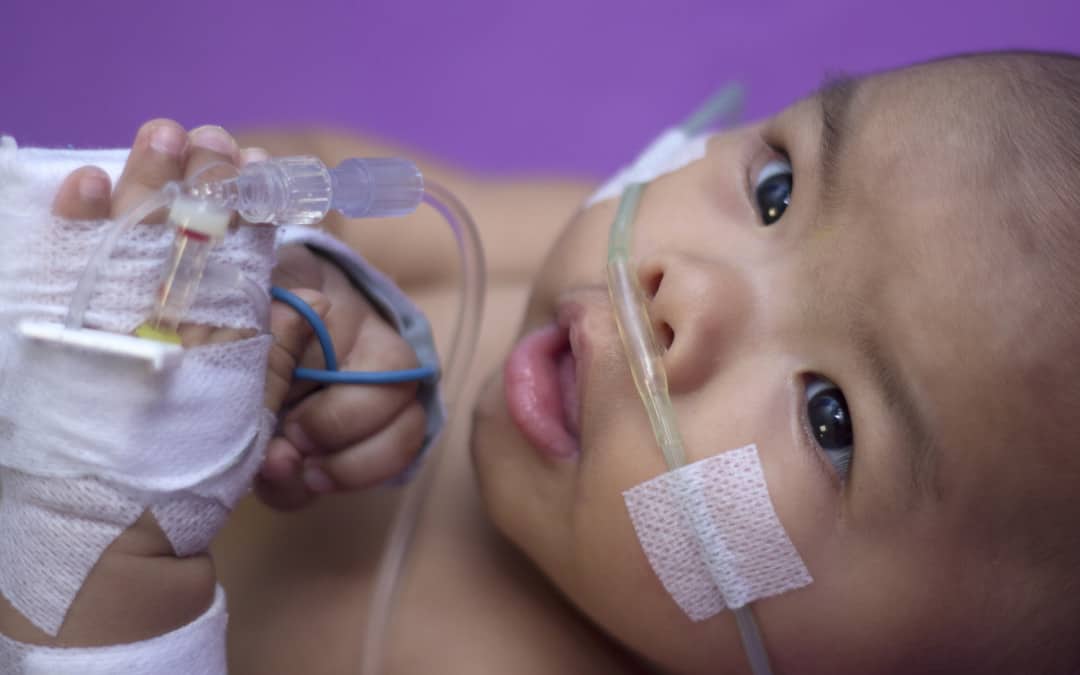Listen to the Podcast
Background & Initial Management
Bronchiolitis is a viral infection of the lower airways, most often in infants but can affect children up to two years of age. It is commonly caused by respiratory syncytial virus (RSV), although it can be caused by numerous other viruses and it has a peak incidence in the autumn/winter. Affected infants present with coryzal symptoms, moist cough, reduced feeding and low grade pyrexia. Typical chest signs include varying degrees of respiratory distress, fine scattered crackles and wheeze.
Management is largely supportive including maintaining clear nasal passages (suction and saline nasal drops), 3% hypertonic saline nebulisers (improves airway narrowing by reducing mucosal oedema and increasing clearance of secretions) and maintaining hydration with nasogastric feeds/intravenous fluids as required. There is no evidence that steroids or bronchodilators such as salbutamol/ipratropium help in this condition, however a trial may be considered in children > 6 months of age. Antibiotics are not administrated unless there is suspicion of secondary bacterial infection. Nebulised adrenaline is often prescribed along with hypertonic saline for more severe bronchiolitis (reduces mucosal oedema) although evidence that it improves outcomes is lacking.
Infants with more severe bronchiolitis tend to come to the attention of PICU staff with either respiratory failure or apnoeas. Provision of non-invasive respiratory support at an early time with either high-flow oxygen or nasal CPAP, if it can be provided at ward level, may help with both these problems and prevent intensive care admission. Although evidence is lacking caffeine citrate is often tried in babies having apnoeas.
Intensive Care
Airway
Indications for intubation include hypoxia/SpO2 <92% refractory to 60% supplemental oxygen, respiratory failure refractory to ‘high flow oxygen’ or nasal CPAP (or inability to provide non-invasive support locally), reduced level of consciousness, exhaustion or recurrent apnoeas. Intervene earlier in high risk patients (congenital heart disease, chronic lung disease, ex-premature infant, immunodeficiency or neuromuscular disorder).
Clear nasal passages using a flexible suction catheter.
Deliver PEEP using Ayre’s T-Piece and facemask while preparation for intubation are made.
Preoxygenate and consider administering 10 ml/kg 0.9% saline fluid bolus prior to induction and set non-invasive blood pressure to cycle every minute during induction.
Suggest using 1 – 2 mg/kg of ketamine, 1 mg/kg of rocuronium +/- 20 mcg/kg (minimum dose = 100 micrograms) of atropine prophylactically as risk of bradycardia during intubation of the sick infant is high (also the reason to avoid use of suxamethonium).
Insert a nasogastric tube and aspirate stomach prior to induction and task someone to continue to aspirate air from the stomach as mask ventilation commences (patient will require gentle ventilatory support during the apnoea period and despite this is still likely to desaturate even with slick intubation).
A straight blade generally provides a better view than a curved blade in infants due to laxity in the glossoepiglottic ligament. You should be able to intubate most infants with bronchiolitis using a Miller size 1 blade and consider using a Mac 2 blade from six months of age. Bimanual laryngoscopy (external manipulation of the larynx by the intubator) can often improve the view in small babies.
Use a size 3.0mm cuffed tube for term infants >3kg – 7 months and a size 3.5mm cuffed tube between 8 – 23 months. For uncuffed endotracheal tubes use a size 3.0mm tube for babies < 2.5 kg, a 3.5mm tube, between 2.5 – 5 kg, a 4.0mm tube between 5 – 10 kg and a 4.5mm tube >10kg. See the formulae below for depth of insertion of the endotracheal tube.
Neonate
Oral ET tube length (cm) = weight (kg) + 6
Nasal ET tube length (cm) = weight (kg) + 7
Infant
Oral ET tube length (cm) = (weight in kg)/2) + 8
Nasal ET tube length (cm) = (weight in kg)/2) + 9
During intubation keep head in neutral position, lift epiglottis if using a straight blade and have suction handy (secretions can block view of cords in small infants).
Consider changing oral endotracheal tube to nasal if local skills and patient condition allow.
Breathing
Following intubation suction endotracheal tube and consider instillation of saline/chest physiotherapy if persistent secretions.
Routine settings on ventilator i.e I:E ratio 1:2, PEEP 5 – 8 cm H2O, Ti 0.6 – 0.8 seconds and adjust depending on blood gases.
A peak pressure of around 20 cmH2O or tidal volume of 6-8 ml/kg is a reasonable starting point and adjust depending of chest movement and blood gases.
Ensure the ventilator/circuit you are using is suitable for use in infants (this is a common cause refractory hypercapnia in this age group). Likewise use of large filters, oversized capnography or angle pieces all increase the dead space and may cause hypercapnia.
Continuously monitoring of pulse oximetry and capnography. Check blood gases regularly (capillary gases adequate in most cases).
Target oxygen saturations >92% (relax to 88% if using FiO2 > 60%) and if using high peak pressures >25 cmH2O tolerate permissive hypercapnia and relax blood gas targets to pH > 7.25.
Consider trial of bronchodilators in children > 6 months of age.
Chest radiograph to confirm endotracheal tube position – typical chest radiograph finding in bronchiolitis include hyperinflation and bronchial wall thickening.
Circulation
Two peripheral cannulae will be required, however an arterial or central line is not normally required unless the patient is haemodynamically unstable or if peripheral access proves difficult.
Continuously monitor ECG and set non-invasive blood pressure to cycle every 5 minutes (in the absence of an arterial line).
Disability
Sedate with morphine starting at 20 mcg/kg/hr (range 10 – 60 mcg/kg/hr) and consider adding midazolam at a dose of 1 – 4 mcg/kg/min for infants over 3 months of age.
Administer non-depolarising muscle relaxant by either infusion or bolus for transfer (avoid atracurium in patient with possible asthma).
Monitor blood sugar and assess pupillary reflexes regularly.
Sepsis
Send endotracheal secretions for bacteriology and virology. A bronchoalveolar levage will often be performed once the patient reaches PICU.
If chest radiograph shows evidence of consolidation it is reasonable to cover with antibiotics to cover community acquired pneumonia e.g. 30 mg/kg of intravenous co-amoxiclav. Take blood cultures before administering antibiotics (provided it doesn’t significantly delay their administration).
If there is any suspicion of pertussis e.g. spasms of coughing/lymphocytosis add intravenous clarithromycin at a dose of 7.5 mg/kg.
If the patient is systemically unwell or has a temperature > 39°C ensure you have the correct diagnosis (see collapsed neonate chapter) and provide appropriate antibiotics to cover sepsis (see sepsis chapter).
Renal
Restrict intravenous fluids to 80% maintenance.
Use isotonic fluids (risk of SIADH) e.g. 0.9% saline and 5% dextrose or 0.9% saline and 10% dextrose in neonates +/- added KCL.
Bladder catheterisation is not normally required.
Gastrointestinal
Keep nil by mouth.
Insert and aspirate nasogastric tube (to remove any swallowed air splinting the diaphragm), then leave on free drainage.
Labs & Electrolytes
Routinely check FBP, U&E, CRP, blood gas and lactate.
Send blood cultures if starting antibiotics and send secretions for bacteriology/virology.
Drugs & Infusions
Hypertonic Saline 3%
Acts as a mucolytic by loosening thick stick secretions that can block the airways and also helps reduce mucosal oedema. Administration can however cause temporary irritation and bronchospasm which can be reduced by administering with a bronchodilator e.g. adrenaline.
Administer 4 ml of 3% hypertonic saline by oxygen driven nebuliser repeating 6-8 hourly as required.
Adrenaline
Nebulised adrenaline acts by reducing mucosa oedema and therefore lower airway narrowing.
Administer 2mg (2ml of Adrenaline 1 in 1,000) by adding it to the 3% hypertonic saline nebuliser or on its own by diluting in an equal volume of 0.9% saline. If effective can be administered regularly together with the hypertonic saline nebulisers.
Caffeine Citrate
Can be considered for apnoeas in bronchiolitis.
Administer a loading dose of 20 mg/kg of caffeine citrate as a loading dose by intravenous infusion over 30 minutes. If effective consider maintenance therapy after 24 hours.
NB Always prescribe as Caffeine Citrate (Caffeine citrate 2 mg ≡ caffeine base 1 mg).
Additional Information
For refractory or hypoxia secondary to bronchiolitis carry out a DOPES assessment and discuss urgently with the retrieval team:
Displaced endotracheal tube
Obstructed endotracheal tube
Pneumothorax
Equipment failure
Stacked breaths or Stomach (full stomach splinting diaphragm)
If the DOPES assessment doesn’t help the retrieval team should advise on additional management. It will be important ensure you have the correct diagnosis. Important diagnoses to exclude include congenital heart disease (see collapse neonate chapter), pulmonary hypertension, asthma (may respond to bronchodilators) and pertussis (leucocytosis causing impaired pulmonary blood flow may require exchange transfusion). Interventions that the retrieval team may recommend include trial of bronchodilators/steroids, DNase, prone positioning or chest physiotherapy. Interventions not normally available locally (but by keeping the retrieval up to date with progress will allow these to be considered at an early stage) include trial of nitric oxide, HFOV, bronchoscopy, surfactant administration and extracorporeal life support (ECLS).
![]()


good piece of information covered